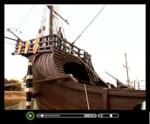Christopher Columbus
Christopher Columbus – Birth of an Explorer
Christopher Columbus was born in 1451 in beautiful Genoa, Italy. He was raised in the shadows of medieval gates behind him and the open sea in front of him -- the perfect backdrop for a boy looking for adventure.
Christopher's father was a respectable middle-class man who made a career of weaving wool. But Columbus had bigger plans than spending his life working with sheep fur. He had heard the call of the ocean, the lure of the sea. Christopher Columbus set about learning his trade as a teenager, traveling the trade routes across Europe and becoming an expert in navigation. He may have also helped with a bit of “privateering” in the war against the Moors.
Christopher Columbus – A Bold Proposal
Although Christopher Columbus reached his goal of becoming a sea captain, he was not content to simply follow the traditional trade routes and make a nice living. No, he had big plans, and he was willing to risk everything to make them a reality.
During this period, land trade between India, China, and Europe dwindled, because the Muslims had effectively created a blockade of the trade routes, including the famous Silk Road. Many Europeans were wondering, "How do we solve this trade problem?"
Along comes a mathematician named Paolo Toscanelli, toiling away quietly at a cathedral in Florence, Italy, who proposes a new theory of reaching the East by sailing west. Then along comes Christopher Columbus, who believes he's called by God to find a new trade route, and help fulfill the Great Commission. However, before Christopher Columbus could set sail, he needed official sponsorship from a throne. So around the year 1485, Columbus came up with a bold proposal.
Christopher Columbus – A Difficult Pitch
Christopher Columbus spent 20 years traveling through Europe trying to meet with any royalty who would listen to his pitch. He presented his concept to the king of Portugal, possibly as early as 1471, then years later, to England and France. Every time he was rejected.
Columbus, often traveling with his son Diego, was rejected on multiple occasions in Spain in the 1490s. His idea was too extreme, too risky, and the timing was just wrong. Columbus was out of options. What he needed was a miracle. A monastery seemed like a good place to find one. When Christopher Columbus knocked on the doors of La Rabida near Palos, Spain, he was at the lowest point of his entire life. He was penniless, hungry, and couldn't even afford food to eat with his young son, Diego in tow. The two had been all over Europe, speaking before kings, looking for money to fund his voyage, to no avail.
It was two monks from La Rabida who took him in, fed him, and took care of him. But little did Columbus know that these two monks weren't your normal monks. They had friends in high places. One of the monks, Father Juan Perez, became a friend and supporter of Columbus. Columbus explained that his last resort was going to be one more meeting with the King of France. But Father Perez decided it was time to use his connections. Conveniently, one of Father Perez's duties was to hear the confessions of the Queen of Spain. Christopher Columbus was allowed into the royal court of Spain where he made his big pitch to the monarchs, Ferdinand and Isabella.
But this time, things were different. After 700 years of Islamic domination in Spain, Ferdinand and Isabella had successfully defeated the Muslims, called the Spanish Moors, in a recent battle. They had driven the Moors out of the key port city of Granada in the south. Spain was now unified and peace was now the norm. The monarchs were in a mood to expand.
Christopher Columbus – A Monumental Voyage
Christopher Columbus got virtually everything he had hoped and prayed for. He had found royal patrons, which took care of the financing he needed for ships, supplies, and crews. He had even asked for "a piece of the action." If he discovered gold or other riches, he would get a percentage of everything, along with getting the naming rights and becoming the ruler of any new lands he discovered.
On August 3, 1492, Christopher Columbus and some 90 other mariners boarded their ships in the Spanish town of Palos de la Frontera and set sail in the three famous boats, the "Nina," the "Pinta," and the "Santa Maria." It was here that Columbus gathered most of his crew, including the Pinzon brothers, local men famous for their navigational skills who would captain the "Nina" and "Pinta." Of course, Christopher Columbus captained the ship named after Saint Mary, the mother of Jesus, who was central figure at the monastery of Juan Perez, where Columbus ultimately found hope.



